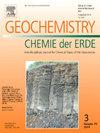Mineral chemistry and garnet U-Pb dating in the Bizmişen iron skarn deposit, Erzincan, East-Central Türkiye
IF 2.9
3区 地球科学
Q2 GEOCHEMISTRY & GEOPHYSICS
引用次数: 0
Abstract
In Bizmişen area, Middle Eocene (46.3–42.0 Ma) plutonic rocks (quartz diorite) were intruded into Triassic-Cretaceous limestones and Upper Cretaceous ophiolites and caused to skarn zones containing prograde (garnet, clinopyroxene) and retrograde (amphibole, epidote, calcite, magnetite, phlogopite, serpentinite and chlorite) minerals. Due to contact relationships of quartz diorites with both serpentinized ultramafic rocks and limestone blocks, the mineralogical associations represent calcic (grossular/andradite, amphibole, chlorite and epidote) as well as magnesian (diopside, serpentine, phlogopite, talc) skarns. During the skarnization process, garnet, diopside, epidote, scapolite and amphibole minerals developed in the endoskarn zone within quartz-diorite, and diopside, tremolite, serpentine, phlogopite, talc, Mg-chlorite and calcite minerals developed in the exoskarn zones in ophiolites (serpantinite and listwaenite) and limestones. Skarn and magmatic clinopyroxenes in serpentinized ultramafic hosted exoskarn zone have a compositional range of Wo45-53En35-53Fs0–15 and Wo24-51En38-76Fs0–11, and classified as diopside and augite, respectively. The end members of garnets are Adr46–54Grs43–50Prp1–2Sps1.1–5 in amphibole-epidote-calcite-garnet skarn in endoskarn zone, whereas Adr40–93Grs4–57Prp0.2–2.3Sps0.9–2 in epidote-calcite-garnet skarn in exoskarn zone, and classified as andradite-rich grandite garnets. FeO, MnO and partially MgO contents gradually increase from the edges to the center in zoned garnet grains. Amphibole compositions represent to calcic (Ca >1 atoms per formula unit) group (pargasite) and indicate the high oxygen fugacity conditions which caused the increase in the rate of magnetite crystallization. Al2O3 and FeO contents of epidotes range 23.68–27.63 and 9.10–14.45 wt%, respectively, correspond to composition of epidote and clinozoisite. The iron oxide contents (FeO, wt%) of magnetites change from 91.72 to 98.36 correspond to structural Fe3+1.88–1.97 and Fe2+0.91–1.0 values. The contents of Ti, divalent and trivalent metal cations correspond to ulvospinel-magnetite compositional line at the magnetite end-member. The mineral chemistry of skarn minerals shows similarities to those of most iron skarn deposits. Garnet U-Pb ages (46.95–45.63 Ma) are consistent with the cooling ages of the Bizmişen pluton. The prograde stage of skarn should be occurred syn-intrusion, whereas retrograde stage should be developed later than youngest garnet age (45.6 Ma) and before the oldest late stage argillic alteration (37.5 Ma).
图尔基耶中东部埃尔津詹 Bizmişen 铁矽卡岩矿床的矿物化学和石榴石 U-Pb 定年
bizmi地区中始新世(46.3 ~ 42.0 Ma)深部岩体(石英闪长岩)侵入三叠系—白垩系灰岩和上白垩系蛇绿岩,形成了顺进(石榴石、斜辉石)和逆行(角闪石、绿帘石、方解石、磁铁矿、辉云母、蛇纹岩和绿泥石)矿物的矽卡岩带。由于石英闪长岩与蛇纹石化超镁铁质岩和石灰岩块体的接触关系,其矿物学组合为钙质(粗晶/角闪石、绿泥石和绿帘石)和镁质(透辉石、蛇纹石、绿云母、滑石)夕卡岩。在矽卡岩化过程中,石英闪长岩的内矽卡岩带发育石榴石、透辉石、绿帘石、角闪石等矿物,蛇绿岩(蛇纹石和李氏石)和石灰石的外矽卡岩带发育透辉石、透闪石、蛇纹石、绢云母、滑石、镁绿泥石和方解石等矿物。蛇纹化超镁铁型外矽卡岩带夕卡岩和岩浆斜辉石的组成范围为wo45 - 53en35 - 53f50 - 15和wo24 - 51en38 - 76f50 - 11,分别为透辉石和辉长岩。内矽卡岩带角闪石-绿帘石-方解石-石榴石矽卡岩的端元为Adr46-54Grs43-50Prp1-2Sps1.1-5,外矽卡岩带绿帘石-方解石-石榴石矽卡岩的端元为adr40 - 93grs4 - 57prp1 - 0.2 - 2.3 sps0.9 - 2,属于富绿锰矿的花岗榴石。在分带的石榴石晶粒中,FeO、MnO和部分MgO含量由边缘向中心逐渐增加。角闪孔组成为钙(Ca >;1个原子/分子式单位)基团(闪石),表明高氧逸度条件导致磁铁矿结晶速率加快。绿帘石的Al2O3和FeO含量分别为23.68 ~ 27.63 wt%和9.10 ~ 14.45 wt%,对应于绿帘石和斜黝帘石的组成。磁铁矿的氧化铁含量(FeO, wt%)在91.72 ~ 98.36之间变化,对应于Fe3+1.88 ~ 1.97和Fe2+0.91 ~ 1.0的结构值。在磁铁矿端元处,钛、二价和三价金属阳离子的含量对应于乌尖石-磁铁矿的组成线。矽卡岩矿物的矿物化学特征与大多数铁矽卡岩矿床相似。石榴石U-Pb年龄(46.95 ~ 45.63 Ma)与bizmi岩体的冷却年龄一致。矽卡岩的进行阶段应发生在同侵入期,而逆行阶段应发育在最年轻的石榴石时代(45.6 Ma)之后,最古老的晚期泥质蚀变(37.5 Ma)之前。
本文章由计算机程序翻译,如有差异,请以英文原文为准。
求助全文
约1分钟内获得全文
求助全文
来源期刊

Chemie Der Erde-Geochemistry
地学-地球化学与地球物理
CiteScore
7.10
自引率
0.00%
发文量
40
审稿时长
3.0 months
期刊介绍:
GEOCHEMISTRY was founded as Chemie der Erde 1914 in Jena, and, hence, is one of the oldest journals for geochemistry-related topics.
GEOCHEMISTRY (formerly Chemie der Erde / Geochemistry) publishes original research papers, short communications, reviews of selected topics, and high-class invited review articles addressed at broad geosciences audience. Publications dealing with interdisciplinary questions are particularly welcome. Young scientists are especially encouraged to submit their work. Contributions will be published exclusively in English. The journal, through very personalized consultation and its worldwide distribution, offers entry into the world of international scientific communication, and promotes interdisciplinary discussion on chemical problems in a broad spectrum of geosciences.
The following topics are covered by the expertise of the members of the editorial board (see below):
-cosmochemistry, meteoritics-
igneous, metamorphic, and sedimentary petrology-
volcanology-
low & high temperature geochemistry-
experimental - theoretical - field related studies-
mineralogy - crystallography-
environmental geosciences-
archaeometry
 求助内容:
求助内容: 应助结果提醒方式:
应助结果提醒方式:


